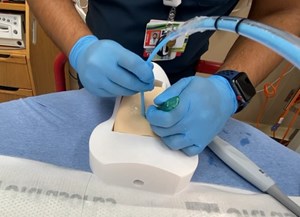
Probing the Literature National Journal Club: Ultrasonography in Sepsis
Session Date: September 26, 2023
Ethan Kimball, DO
Guest Speaker: Robert Ehrman MD, MS, Detroit Medical Center, Wayne State University
Ehrman RR, Ottenhoff JD, Favot MJ, Harrison NE, Khait L, Welch RD, Levy PD, Sherwin RL. Do septic patients with reduced left ventricular ejection fraction require a low-volume resuscitative strategy? Am J Emerg Med. 2022 Feb;52:187-190. doi: 10.1016/j.ajem.2021.11.046. Epub 2021 Dec 8. PMID: 34952322.
At this month’s journal club, we had the great pleasure of having Dr. Robert Ehrman MD as our guest speaker to present his research on the use of ultrasonography in managing patients with reduced ejection fraction who present to the emergency department with sepsis, “Do septic patients with reduced left ventricular ejection fraction require a low-volume resuscitative strategy?” was published in the American Journal of Emergency Medicine in 2021. Dr. Ehrman has a long-standing interest in the use of ultrasound to assess a patient’s volume status. While POCUS has become widely used in the evaluation of patients with hypotension and sepsis, the work of Dr. Ehrman and others suggests that the exact findings that reflect volume responsiveness are not completely understood. In particular, volume assessment in patients with reduced left ventricular ejection fraction (EF) continues to be an area of uncertainty. Many clinicians would hesitate to give a full 3 liter or 30cc/kg bolus to a septic patient with an EF less than 30% out of concern for putting that patient into a volume overloaded state. Dr. Ehrman however asks if this hesitation is well substantiated.
Previous studies have relied on documented ultrasounds in the medical records from as long as two years prior to the patient’s presentation. It is well established that the myocardium’s contractility will be affected by the catecholamine surge during high stress as well as other components of a concomitant systemic infection. It is also possible the patient’s ejection fraction and heart function have changed since the previously documented echocardiogram. In order to overcome this possible discrepancy between the previous and current EF, Dr. Ehrman had a point of care echocardiogram performed upon the patient’s arrival to the emergency department.
This was a pre-planned secondary analysis of a prospective observational study performed evaluating the association between pre-resuscitative cardiac function and illness severity in an urban teaching hospital emergency department. Patients were eligible if they were over 18 years old, were being treated for an infection and had either a systolic blood pressure less than 90 or a lactate greater than 2. Patients were excluded if they were incarcerated, pregnant or received over 1 liter of intravenous fluids prior to evaluation.
The study enrolled 73 patients and bedside ultrasounds were performed by a sonographer who was not a part of the patient’s treatment team as they were blinded to the study’s findings. The images were then evaluated later by ultrasound fellowship trained physicians. It was determined that 33 patients had a reduced ejection fraction, less than 40%, while 40 patients had a normal ejection fraction. It was observed that patients with a reduced ejection fraction where on average older (64.4) as compared to patients with normal ejection fraction (58.6), additionally they had overall more comorbidities such as end-stage renal disease, coronary artery disease, and chronic obstructive pulmonary disease. The patients with a reduced ejection fraction also had higher lactate levels upon admission (4.1 vs 2.9), and NT-pro BNP (1661 vs 91) among other differences.
The analysis compared patients with normal EF versus depressed EF. The authors evaluated hospital length of stay (LOS), ICU LOS, days on a mechanical ventilator, and in-hospital death as a comparison between the two groups. In conclusion the authors found that septic patients with reduced EF who received similar volumes of intravenous fluids did not have increased adverse outcomes attributable to volume overload. They acknowledged that further studies will need to be performed to better extrapolate specific identifiers that place patients at an increased risk for becoming volume overloaded. They do not believe that ejection fraction alone is an accurate marker for volume tolerance.



